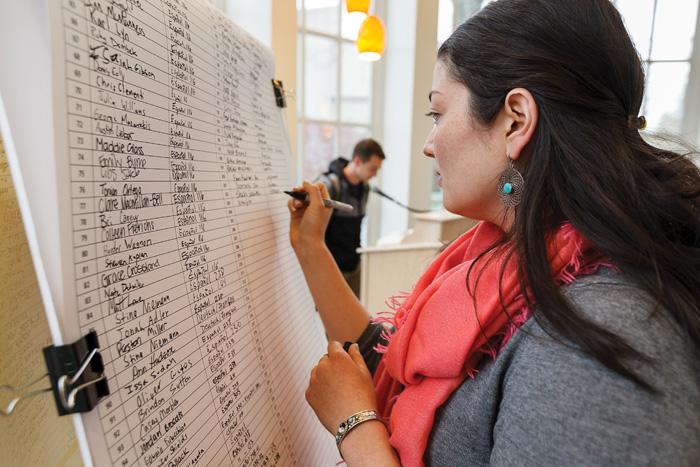(Not) Lost in Translation

by Michelle Simmons
Twelve hours. Six locations—four local and two abroad. Twelve languages and 251 readers. This is how the Dickinson community celebrated Día del Libro in April: with a nonstop reading of Miguel de Cervantes’ El Ingenioso Hidalgo Don Quijote de la Mancha (better known as Don Quixote). International attention is high, with the 400th anniversary of the publication of the novel’s second part (the first was published in 1605) and the recent disinterment of Cervantes’ bones by a team of forensic scientists.
It wasn’t always so. As Ilan Stavans noted in The New Yorker in March, Cervantes was “the most anti-Spanish
of Spanish writers,” and Don Quixote “pokes fun at almost every aspect of life in seventeenth-century Castille, from the Inquisition to manly courage, from lower-class parlance to literature itself. His humorous eye made the entire country look wretched.” Yet his tale captivated the Spanish imagination—and well beyond. Considered the first modern novel, Don Quixote traces the misadventures of Alonso Quixano (who renames himself Don Quixote), his squire, Sancho Panza, and their two loyal equine companions, Rocinante and Dapple. “Don Quixote is a very good reminder of why we read, why we watch movies, why we need fiction and imagination,” says Antonio Rivas, visiting professor of Spanish & Portuguese. “It shows the power of literature, imagination—but also language.”
“Every book that comes after Don Quixote is but a footnote,” adds Professor of Spanish Alberto Rodriguez. “I have read Don Quixote 25 times, and it’s always a new book.”
And even with modern editions clocking in at 1,000-plus pages, the novel is the second-most translated book in the world; only the Bible has been read in more languages.
And as expected, language and literature were at the forefront of Dickinson’s Día del Libro. Organized by the Department of Spanish & Portuguese, the event actually covered two days (April 22-23) and several academic departments. On the first day, the campus community saw two of Cervantes’ one-act plays, participated in a roundtable discussion among Cervantes scholars (conducted in Spanish) and viewed the Soviet-era film Don Quixote by Grigori Kosintsev, which was sponsored by the Russian and Spanish departments.
The second day—the Day of the Book—began with a Spanish-style breakfast in Bosler Hall’s atrium and the first paragraph read by President Nancy A. Roseman. Midmorning, students studying abroad in Malaga and Mendoza were skyped in and Michael Bogdan ’05, who teaches Spanish at nearby Boiling Springs High School, brought his class.
As the movable feast traveled to the Stafford Reading Room in the Waidner- Spahr Library, staff made available translated copies for those readers who did not have their own: Arabic, Mandarin, Korean, Japanese, French, German, Polish, Portuguese, Russian, Italian, Hebrew. A late reader pulled his copy in Bulgarian from his iPhone.
And while mobile technology added more international flavor to the celebration, the historical import of print was on full view, with the library’s acquisition of several rare editions for its special collections. On display were several illustrated editions in both English and Spanish: 1742 and 1819 (London), 1864 and 1906 (New York) and 1797 (Madrid) and 1969 (Buenos Aires).
The evening ended with a dinner reception, capped off with a performance by Dickinson’s newest a cappella group, the Crescendevils. “This is literature that brings the world together,” says Rogelio Cerezo ’15, a political-science major from Panama, whose high school celebrates Dia del Libro every year. “I felt so good to be able to participate here.”
Read more from the summer 2015 issue of Dickinson Magazine.
Learn More
Published July 28, 2015